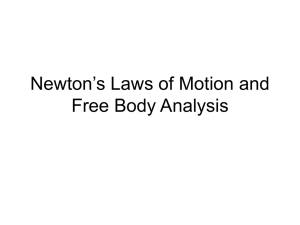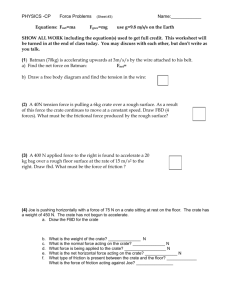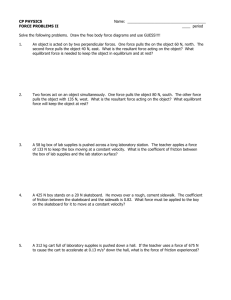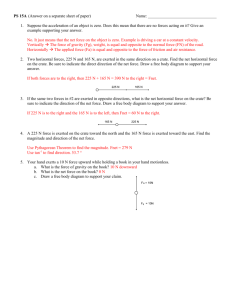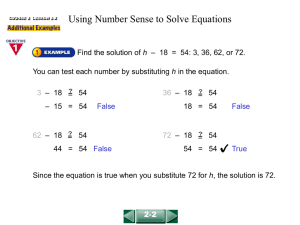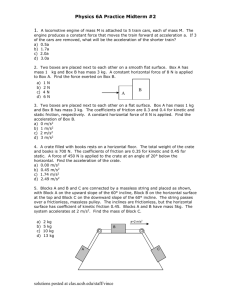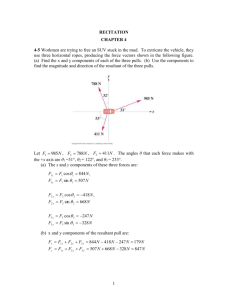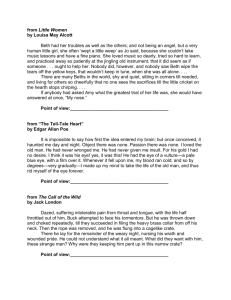Topic 2 Problem Set 2016
advertisement
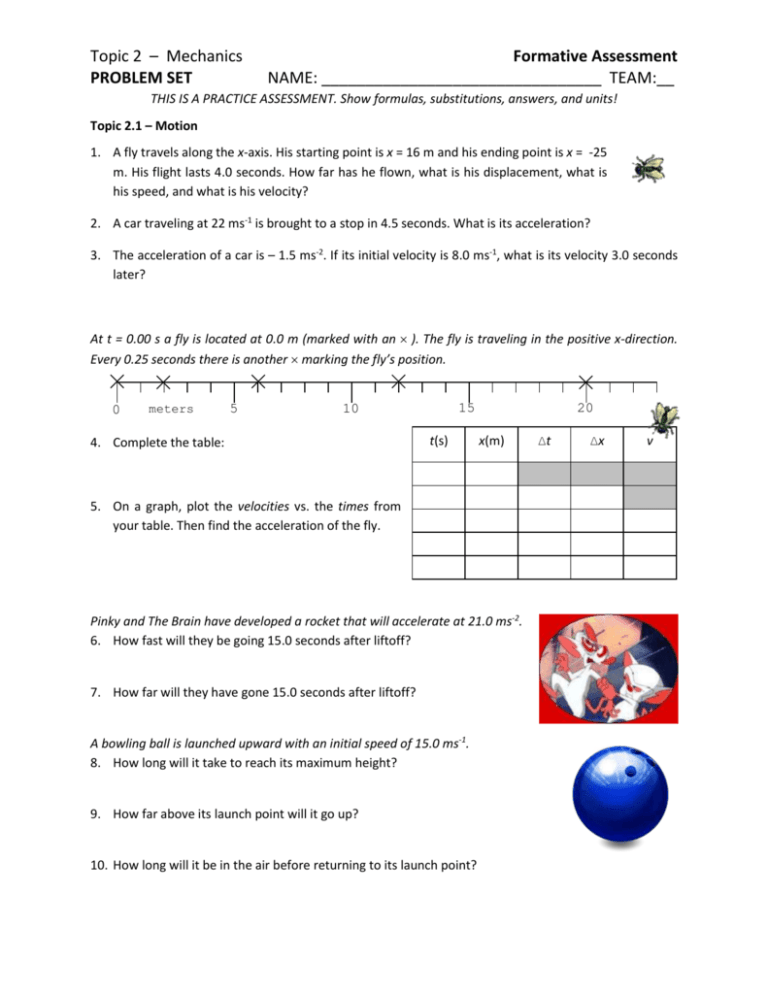
Topic 2 – Mechanics PROBLEM SET Formative Assessment NAME: ________________________________ TEAM:__ THIS IS A PRACTICE ASSESSMENT. Show formulas, substitutions, answers, and units! Topic 2.1 – Motion 1. A fly travels along the x-axis. His starting point is x = 16 m and his ending point is x = -25 m. His flight lasts 4.0 seconds. How far has he flown, what is his displacement, what is his speed, and what is his velocity? 2. A car traveling at 22 ms-1 is brought to a stop in 4.5 seconds. What is its acceleration? 3. The acceleration of a car is – 1.5 ms-2. If its initial velocity is 8.0 ms-1, what is its velocity 3.0 seconds later? At t = 0.00 s a fly is located at 0.0 m (marked with an ). The fly is traveling in the positive x-direction. Every 0.25 seconds there is another marking the fly’s position. 0 meters 5 15 10 4. Complete the table: t(s) 20 x(m) 5. On a graph, plot the velocities vs. the times from your table. Then find the acceleration of the fly. Pinky and The Brain have developed a rocket that will accelerate at 21.0 ms-2. 6. How fast will they be going 15.0 seconds after liftoff? 7. How far will they have gone 15.0 seconds after liftoff? A bowling ball is launched upward with an initial speed of 15.0 ms-1. 8. How long will it take to reach its maximum height? 9. How far above its launch point will it go up? 10. How long will it be in the air before returning to its launch point? ∆t ∆x v A bowling ball is dropped from a balcony on the Tower of Pisa that is 45 m above the ground. 11. How long will it take to reach the ground? 12. What will its speed be when it reaches the ground? A bowling ball is thrown downward at 15 ms-1 from a balcony on the Tower of Pisa that is 45 m above the ground. 13. What will its speed be when it reaches the ground? 14. How long will it take to reach the ground? v / ms-1 A whale is in free-fall. Her speed vs. time is plotted in the graph. 15. Draw labeled free-body diagrams of the 30 whale at the times t = 0 s, t = 20 s, and t = 50 s. 16. What is her terminal speed? 15 17. What is her instantaneous acceleration at t = 10 s? 0 0 18. Explain how you would find the total displacement of the whale during her first 30 seconds of freefall from the above graph. Then estimate it. 10 19. What does the slope of a velocity vs. time graph tell you? 20. What does the area under an acceleration vs. time graph tell you? Two cars A and B are driving at velocities represented below as scale arrows. 21. Sketch accurately the vector representing the velocity of A relative to B on the grid provided. Make it the same scale. vB vA 20 30 40 t /s 22. If the grid lines in the previous graph represent 1 ms-1 increments, find the magnitude of the vector you drew representing the velocity of A relative to B. Be very exact! Topic 2.2 – Forces 23. What is the weight of an 85-kg person? Draw a free body diagram of that person standing on the ground. Be sure to include labels on all of the forces you have included. 24. A wooden crate is being dragged along a floor to the right with a tension of 60 n being applied at an angle of 40° above the horizontal. There is friction between the crate and the floor. Draw a labeled free body diagram of the crate. 25. If the crate of the previous problem is not accelerating, what is the value of the friction force? 26. List the contact force(s) we have discussed. List the action-at-a-distance force(s) we have discussed. A 75-kg mass is supported by three cables as shown. The two cables anchored to the ceiling make an angle of 45 with the ceiling. The three tensions are labeled. 27. Find the numeric value of T3. 45° 45° T1 T2 knot T3 28. Find the numeric values of T1 and T2. 29. A 15-kg crate being pulled leftward by a force of 25 N, has a dynamic friction force of 18 N. Make a free-body diagram of the crate which includes all forces acting on it. Then find the acceleration of the crate. 30. What is the acceleration of a 680-newton person who is experiencing a net force of 300 n? There are exactly two forces acting on the 25-kg crate, as shown. 31. What is the resultant force acting on it? 200 n 400 n 30° 32. What is the acceleration of the crate? A 25-N crate is given an initial velocity of 8.0 ms-1 on a floor. It slides 12 m. 33. Find the constant acceleration of the crate, the friction force that stops the crate, and the coefficient of dynamic friction between the crate and the floor. 34. Explain why it initially takes a greater force to make a crate slide than it does to keep that crate sliding once it has begun. 35. Explain the concept of antilock brakes, and why they stop a car in a shorter distance than brakes that completely lock the wheels so that the car skids (the rubber of the wheels slides on the pavement, rather than rolls). 36. Consider the two crates resting on the floor. Draw a free-body diagram for each of the crates. Label the forces. Then consider all of the forces you labeled. Which pairs, if any, are action-reaction pairs? Topic 2.3 – Work, energy and power 37. An 820-kg Smart Car has an acceleration of 1.5 ms-2. What is the work done by the net force acting on the car if it travels 125 meters? 30° 38. What is the work done by the 300.-N tension shown if it is used to drag the 250-N crate 45 m across the floor at a constant speed? 10 F /N 39. What is the work done by the variable force whose graph is shown from x = 1.0 to x = 3.0 m? 0 0.0 1.0 The Smart Car shown in the picture has speed and mass as shown. 40. What is the kinetic energy of the car at this moment? 2.0 3.0 x/m v = 20. ms-1 850 kg 41. If the driver suddenly applies the brakes and brings the car to a stop in 4.0 s, what is the work done by the friction force between the tires and the road surface? 42. What is the average friction force during the braking action? 43. Suppose the car drives up a hill whose altitude is 45 m above the car’s starting point. What is the change in potential energy of the car in going up the hill from its starting point? 44. If the car in the previous problem begins to slide down the ice-covered and (magically) frictionless hill, what will its speed be when it is at an altitude of 25 m? 45. What will its speed be when it reaches the bottom of the hill? A Smart Car accelerates from rest as shown. 46. If the constant acceleration occurs over a distance of 50. m, what is the work done by the car in accelerating itself? a = 3.0 ms-2 820 kg 47. How long does the acceleration take? 48. What, then, is the output power produced by the engine during the acceleration? Topic 2.4 – Momentum and impulse 100 49. A 2.5-kg mass is traveling to the left at 2.0 ms . It then experiences an impulse represented in the F vs. t graph shown here. What is the total impulse given to the ball? 50. What is the change in momentum of the ball? F /n -1 50 0 0 .0 0 .1 0.2 0.3 0.4 51. What is the final velocity of the ball? Two Smart Cars are on a collision course, as shown. 52. What is the total initial momentum of the two cars? 53. The two cars collide and stick together. What is their velocity immediately after the collision? 54. What is the change in kinetic energy of the two-car system? t/s A 3.25-gram bullet traveling at 345 ms-1 strikes and enters a 2.50-kg crate. The crate slides 0.75 m along a wood floor until it comes to rest. 55. What is the speed of the crate/bullet system immediately after the collision? 56. What is the change in kinetic energy of the system after the collision. 57. Find the friction force between the crate and the floor. 58. What is the coefficient of dynamic friction between the crate and the floor? 59. What is the average force applied by the crate on the bullet during collision if the bullet penetrates the 1.25 cm into the crate? A ballistic pendulum consists of a 1.75-kg block of wood that is hanging from the ceiling in such a way that when a bullet enters it, the block’s change in height can be recorded as it swings. A bullet having a mass of 4.50-grams and unknown velocity strikes the block and becomes imbedded in it. The impulse imparted to the block causes it to swing in such a way that its height increases by 5.25 cm. 60. What was the change in potential energy of the block/bullet combo after the collision? h 61. What was the speed of the block/bullet combo immediately after the collision (and before it began to swing)? 62. What was the speed of the bullet before entering the block of wood? A rocket engine uses fuel and oxidizer in a reaction that produces gas particles having a velocity of 1250 ms-1. The desired thrust is to be 252000 N. 63. What must be the fuel/oxidizer consumption rate (in kg s-1)? 64. If the initial weight of the rocket is 125000 N, what is its initial acceleration? 65. What are the weight and acceleration of the rocket at t = 15.0 s after ignition?
